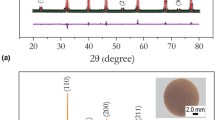Abstract
The high temperature conductivity of polycrystalline Sr1−xTiO3−δ samples in air was found to be lower than the conductivity of SrTiO3 samples. However, the dependence of the electrical conductivity on the oxygen partial pressure showed that this trend can be reverted under reducing conditions. Both trends contradict the expected effects of A-site deficiency on the defect chemistry. Differences in average grain sizes give a plausible explanation for these findings. The dependence of the conductivity on the oxygen partial pressure suggests that p-type conductivity is dominant in air, for every sample, and one can thus assume that the number of grain boundaries plays a negative role on this contribution. Electrochemical permeability measurements confirmed that the ionic transport number of strontium titanate in air remains small.
Access this article
We’re sorry, something doesn't seem to be working properly.
Please try refreshing the page. If that doesn't work, please contact support so we can address the problem.
Similar content being viewed by others
6. References
J. Gerblinger and H. Meixner, Sensors and ActuatorsB4, 99 (1991).
G. Horvath, J. Gerblinger, H. Meixner and J. Giber, Sensors and ActuatorsB4, 93 (1996).
T. Inoue, N. Seki, J. Kaminae, K. Eguchi, and H. Arai, Solid State Ionics48, 283 (1991).
U. Schonauer, Sensors and ActuatorsB4, 431 (1991).
Waser, J. Amer. Ceram. Soc.74 1934 (1991).
J.T.S. Irvine, R.P. Slater, P.A. Wright, Ionics2, 213 (1996).
S. Steinsvik, R. Budge, J. Gjonnes, J. Tafto and T. Norby, J. Phys. Chem. Solids58, 969 (1997)
S.G. Cho and P.F. Johnson, J. Mat. Sci.29, 4866 (1994)
R. Moos and K.H. Härdtl, J. Amer. Ceram. Soc.78, 2569 (1995).
N.H. Chan, R.K. Sharma and D.M. Smyth,128, 1762 (1981)
J.C.C. Abrantes, J.A. Labrincha, J.R. Frade, Ionics3, 16–22 (1997).
S. Witek, D.M. Smyth, H. Pickup, J. Amer. Ceram. Soc.67, 372 (1984).
R.M.C. Marques, F. M. B. Marques, J. R. Frade, Solid State Ionics,73, 15 (1994).
R. Waser, J. Amer. Ceram. Soc.74, 1934 (1991).
M. Vollman and R. Waser, J. Amer. Ceram. Soc.,77, 235 (1994).
M. Vollman and R. Waser, J. of Electroceramics1, 51 (1997).
Y.M. Chiang, T. Takagi, J. Amer. Ceram. Soc.73, 3278 (1990).
S.B. Desu and D.A. Payne, J. Amer. Ceram. Soc.73, 3398 (1990).
Author information
Authors and Affiliations
Rights and permissions
About this article
Cite this article
Abrantes, J.C.C., Ferreira, A.A.L., Labrincha, J.A. et al. Electrical conductivity of Sr1−xTiO3−δ materialsmaterials. Ionics 3, 436–441 (1997). https://doi.org/10.1007/BF02375721
Received:
Accepted:
Issue Date:
DOI: https://doi.org/10.1007/BF02375721




